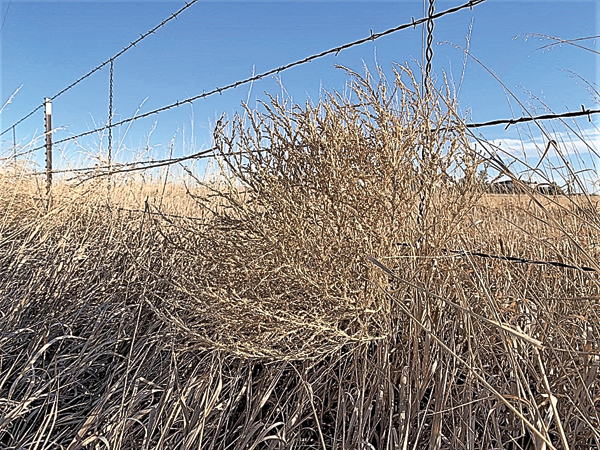
Tumbleweed
A case of botanical kidnapping
As a culture of many cultures, we seem to have a penchant for labeling our subcultures.
The beatniks filled the 1950s coffee houses with poetry, bebop and cool jazz. The 1960s ushered in the hippies, while the soon to arrive yippies were politically active hippies.
The free-spending yuppies arrived on the American scene in the 1980s.
The term “yuppie” is variously defined as “young urban professionals” or “young upwardly mobile professionals.”
The yuppies had little in common with the earlier subcultures. Their philosophy revolved around one principle – making and spending money. And often doing so in an ostentatious manner.
These were the movers and shakers of that time, the three-piecers, the masters of their universe. They were the finely groomed product of prep schools and summers in Europe.
The yuppies took whatever they wanted – when they wanted.
Some would later write myopic autobiographies about how they made and spent their wealth. Others wrote half-hearted confessions admitting to their inherited entitlement as an act of contrition.
Their ilk bought up most of the old brownstones in Chicago with their “disposable income” and set about gentrifying decaying neighborhoods as if it were a righteous crusade.
This eventually ran out the poorer long-term residents as a consequence of driving up property taxes. But, hey, that’s the price of progress, right?
And then there are the shopkeepers, forced out because they didn’t cater to the refined needs of the newest residents. The butcher didn’t sell Kobe beef and the little bar on the corner didn’t serve the latest fancy cocktail or craft brews.
The “mom and pop” bodegas did not carry any artisanal food items at all. They had to go, too.
There is always collateral damage in progress, yes?
I created pseudonyms to disguise real-life characters that I knew pretty well. We’ll call these young urban professionals Madelyn and Douglas.
These two would soon commit a brazen act of botanical abduction. But more on that later.
The thing about the yuppies was their insistence on not shortening their given names to nicknames, which they regarded as rather proletariat. Maddy and Dougie wouldn’t do in their crowd.
They even called each other by their full given names in the privacy of their bedroom. Madelyn insisted on being introduced to others by her full, hyphenated name, in keeping with the times.
She took the additional step of adding her matrilineal name into the mix. However, few could remember Madelyn Rebecca Hardesty-Sprague-Lester.
Most found it easier just to avoid introducing her altogether. Her high-priced therapist helped her through this identity crisis, convincing Madelyn that she was merely a victim of her own name.
This therapy method kicked off the “everyone’s a victim” phenomenon that is still with us today.
In addition to the requisite European travel, the newest trend among the nouveau riche was “doing” a road trip on what remained of old Route 66. The preferred form of transportation was a vintage Ford Mustang, ragtop, and bright red.
Nothing else would do.
Route 66, aka Main Street of America or the Mother Road, ran from Chicago to Los Angeles. That is until it was replaced with an interstate highway.
However, there were still enough old sections left for Madelyn and Douglas to piece it together. Later, the handsome couple would brag in a trendy martini bar that they had “got their kicks” on Route 66.
It wasn’t an original boast, but it was chic, and chic counted in their circles.
Madelyn and Douglas saddled up their red Mustang on a stunningly beautiful October morning. And with their Chicago brownstone in the rearview mirror, they headed down Lakeshore Drive.
In a few minutes, they would turn onto the first mile of U.S. Route 66.
The world was their proverbial oyster, and the open highway awaited them. Although, some trauma and adjustments were to be experienced by the Yupsters on their journey across America.
Sometime later, they lost sight of the Windy City’s skyline and entered the corn and soybean country of the Midwest. Madelyn and Douglas soon discovered that their much-loved cappuccinos and lattes were as scarce as hen’s teeth.
Suffice to say, old Route 66 was a designer-coffee desert.
Such caffeinated drinks would evolve into complicated beverages in the decades just ahead. As a middle-aged couple, they would eagerly join the queue to purchase a “quad long-shot grande in a venti half-caf double cupped, no sleeve, salted caramel mocha latte with two pumps of vanilla white chocolate.”
This dearth of appropriate trendy caffeination continued to haunt the upscale adventurers until they arrived in L.A. Here, their native instincts led them to the closest yuppie enclave, where they could find suitable coffee again.
The same deprivation was imposed on Madelyn and Douglas when they could not find a single bottle of Dom Perignon along the entire stretch of Route 66. Not even at the Lone Star Gun and Liquor Store in Amarillo.
They would later tell their friends that they were forced to drink a six-dollar bottle of Andre Brut in their Teepee-shaped overnight accommodations in Texas.
But, staying in the fiberglass teepee did give them an appreciation of the plight of Native Americans. But they promptly forgot their newfound empathy when they got back on the road and realized that they were both allergic to fiberglass.
They wondered aloud if Native Americans suffered the same allergy. And if they did, why did they build their teepees out of fiberglass?
It is true, Madelyn and Douglas were educated at Ivy League schools, but neither took anthropology or sociology courses, so let’s not be too harsh.
They knew in their hearts that the deprivation they endured on this road trip would be a story that they could tell their children and grandchildren.
That is if they decided to have children – what with the difficulty of getting



